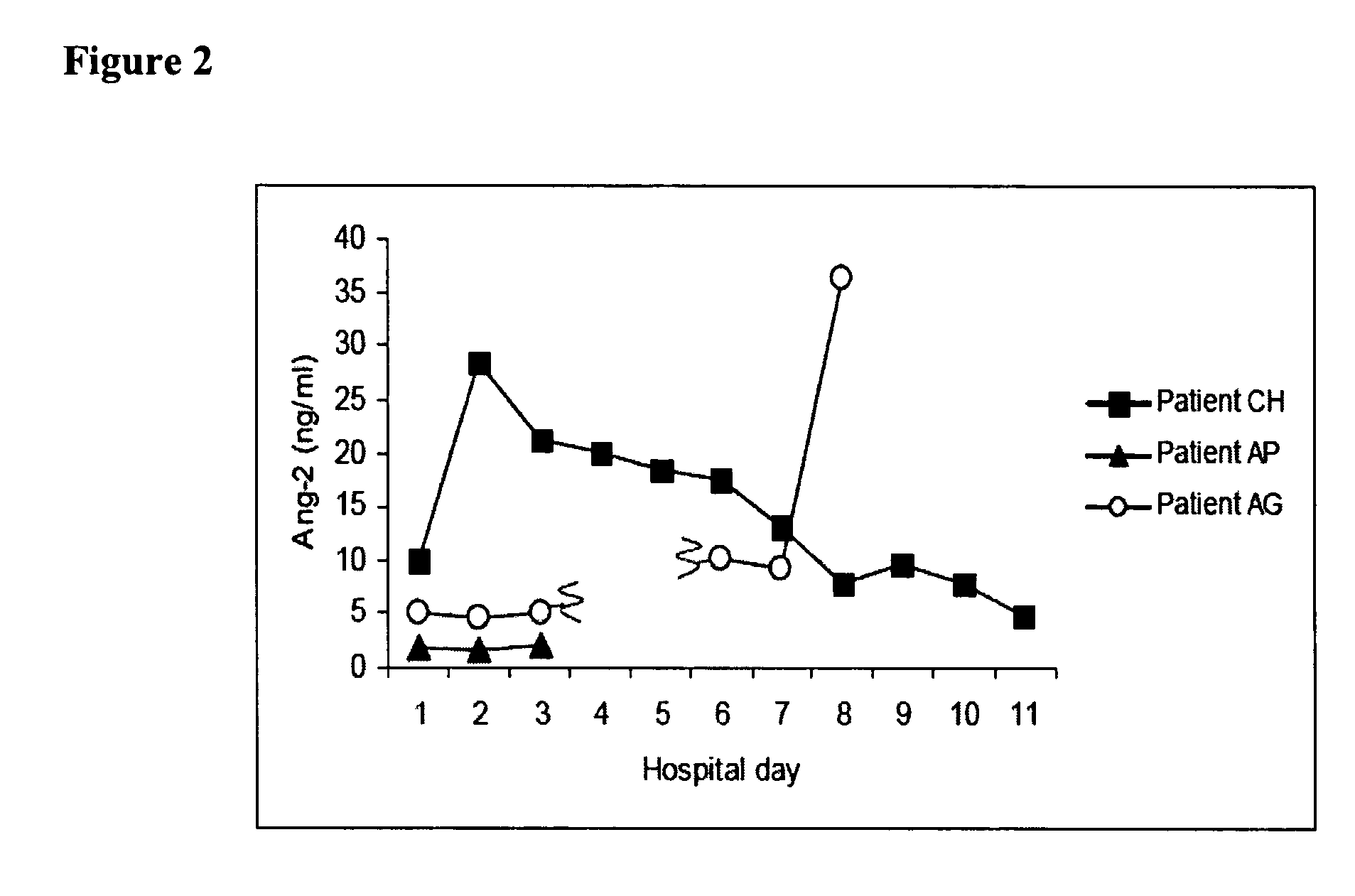Methods and compositions for the treatment and diagnosis of diseases characterized by vascular leak, hypotension, or a procoagulant state
a technology of vascular leakage and composition, applied in the direction of peptide/protein ingredients, depsipeptides, dna/rna fragmentation, etc., can solve the problems of vascular leakage, blood vessels, vascular leakage, etc., to improve the condition of the subject, reduce mortality, and reduce vascular leakage
- Summary
- Abstract
- Description
- Claims
- Application Information
AI Technical Summary
Benefits of technology
Problems solved by technology
Method used
Image
Examples
example 1
Circulating Ang-2 is Significantly Elevated Among Patients with Severe Sepsis
[0210] The baseline characteristics of a cohort of 22 patients identified prospectively by applying the standard definition of sepsis (see Methods) to screen weekday admissions to the ICU at Beth Israel Deaconess Medical Center over a two-month period in 2004 are shown in Table 1, below.
TABLE 1Baseline characteristics of sepsis cohort.CHARACTERISTICVALUENumber of patients22Age (yrs)69.1 ± 15.3Female sex11 (50%) Survival to Discharge16 (73%) APACHE II score21.2 ± 5.3 Portal of EntryLung6 (27%)GU5 (23%)Catheter3 (14%)Abdominal4 (18%)Other2 (9%) foot;1(5%) endocarditis;2 (9%) unknownMaximum number of vasoactive agents usedat any one time during hospitalization06 (27%)17 (32%)26 (27%)33 (14%)Prior / co-morbid conditionsCoronary artery disease8 (36%)Diabetes mellitus9 (41%)Liver disease2 (9%) COPD / asthma6 (27%)Cancer7 (32%)ESRD6 (27%)
[0211] Control patients were selected from control hospitalized patients (n=29...
example 2
Serum from Human Subjects with Sepsis Disrupts Endothelial Architecture, an Effect that Abates with Clinical Convalescence and is Reversed by Ang-1
[0215] Separation of adjacent endothelial cells from one another leads to paracellular gap formation—a process driven by actin-myosin-based cell contraction (McDonald et al., Am J. Physiol. 266: L61-83 (1994), van Hinsbergh et al., J. Anat. 200: 549-560 (2002)). Such gaps permit para-endothelial movement of macromolecules and, thus, represent a structural change that correlates with hyperpermeability. To test what effect human serum had on cultured endothelial cells, we added serum from two patients, CE4 (high Ang-2) and CF1 (low Ang-2) to HMVECs and stained for F-actin and VE-cadherin, a structural protein that helps maintain intercellular junctions. Incubation of HMVECs with control medium (FBS / culture medium) resulted in a compact, confluent cell layer with thin actin filaments and localization of VE-cadherin to cell-cell junctions (F...
example 3
Ang-2 Alone Recapitulates the Effects of Sepsis Serum on Endothelial Architecture and Promotes Hyperpermeability
[0218] Having observed the effect of human serum on cultured endothelial cells described in Example 2, we next tested whether Ang-2 alone could reproduce disruption of endothelial architecture. Recombinant human Ang-2 (100 ng / ml) was added to HMVECs that were subsequently stained for F-actin and VE-cadherin. As suspected, Ang-2 induced the formation of thick actin stress fibers and intercellular gaps (FIG. 5A, panels d-f, arrows), effects not seen with vehicle incubation (FIG. 5, panels A-C). This experiment confirmed the hypothesis raised by the results in FIGS. 4A-4U-namely that Ang-2 alone could provoke potentially pathologic structural changes in endothelium.
[0219] We next confirmed that Ang-2 could modulate barrier function by measuring the clearance of FITC-labeled-albumin across a HMVEC monolayer with and without Ang-2 stimulation. FIG. 5G shows that Ang-2 stimula...
PUM
| Property | Measurement | Unit |
|---|---|---|
| temperature | aaaaa | aaaaa |
| temperature | aaaaa | aaaaa |
| temperature | aaaaa | aaaaa |
Abstract
Description
Claims
Application Information
 Login to View More
Login to View More - R&D
- Intellectual Property
- Life Sciences
- Materials
- Tech Scout
- Unparalleled Data Quality
- Higher Quality Content
- 60% Fewer Hallucinations
Browse by: Latest US Patents, China's latest patents, Technical Efficacy Thesaurus, Application Domain, Technology Topic, Popular Technical Reports.
© 2025 PatSnap. All rights reserved.Legal|Privacy policy|Modern Slavery Act Transparency Statement|Sitemap|About US| Contact US: help@patsnap.com



